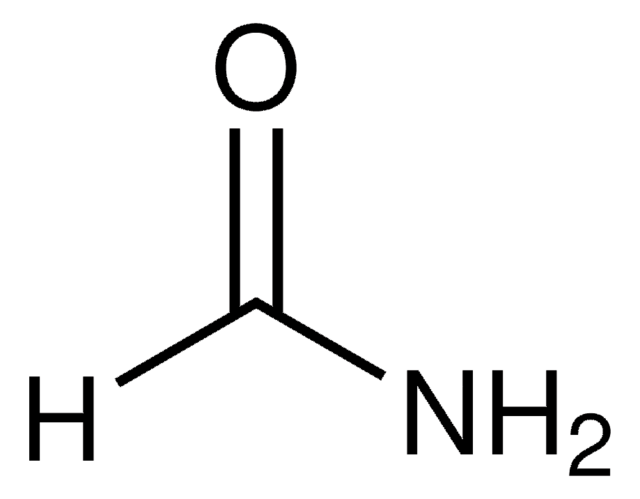47671
Formamide
BioUltra, for molecular biology, ≥99.5% (T)
Sinonimo/i:
Amide C1, Ammide formica
About This Item
Prodotti consigliati
Grado
Molecular Biology
for molecular biology
Densità del vapore
1.55 (vs air)
Tensione di vapore
0.08 mmHg ( 20 °C)
30 mmHg ( 129 °C)
Nome Commerciale
BioUltra
Saggio
≥99.5% (T)
Stato
liquid
Temp. autoaccensione
932 °F
tecniche
FISH: suitable
hybridization: suitable
protein extraction: suitable
Impurezze
DNases, none detected
RNases, none detected
insoluble matter, passes filter test
phosphatases, none detected
proteases, none detected
Residuo alla calcinazione
≤0.1%
Indice di rifrazione
n20/D 1.447 (lit.)
n20/D 1.447
pH
7-9 (25 °C, 1 M in H2O)
P. ebollizione
210 °C (lit.)
Punto di fusione
2-3 °C (lit.)
Solubilità
H2O: 10 M at 20 °C, clear, colorless
Densità
1.134 g/mL at 25 °C (lit.)
Anioni in tracce
chloride (Cl-): ≤1 mg/kg
sulfate (SO42-): ≤10 mg/kg
Cationi in tracce
Ag: ≤5 mg/kg
Al: ≤1 mg/kg
As: ≤0.1 mg/kg
Ba: ≤1 mg/kg
Bi: ≤1 mg/kg
Ca: ≤5 mg/kg
Cd: ≤1 mg/kg
Co: ≤1 mg/kg
Cr: ≤1 mg/kg
Cu: ≤1 mg/kg
Fe: ≤1 mg/kg
K: ≤20 mg/kg
Li: ≤1 mg/kg
Mg: ≤1 mg/kg
Mn: ≤1 mg/kg
Mo: ≤1 mg/kg
NH4+: ≤1000 mg/kg
Na: ≤20 mg/kg
Ni: ≤1 mg/kg
Pb: ≤1 mg/kg
Sr: ≤1 mg/kg
Tl: ≤5 mg/kg
Zn: ≤1 mg/kg
Stringa SMILE
NC=O
λ
10 M in H2O
Assorbanza UV
λ: 260 nm Amax: ≤0.4
λ: 280 nm Amax: ≤0.1
applicazioni
genomic analysis
InChI
1S/CH3NO/c2-1-3/h1H,(H2,2,3)
ZHNUHDYFZUAESO-UHFFFAOYSA-N
Cerchi prodotti simili? Visita Guida al confronto tra prodotti
Descrizione generale
Applicazioni
- as a component in the hybridization buffer for in situ hybridization as a component of solution X to wash the slides to remove the coverslips
- in the preparation of denaturation solution for spectral karyotyping (SKY) analysis
- in the preparation of 1% formaldehyde solution for the pretreatment of slides for comparative genomic hybridization (CGH)
- to prepare pre-hybridization buffer I, II, III, IV, and hybridization buffer I, II, and III for RNA fluorescence in situ hybridization (RNA-FISH)
- as an ionizing solvent in the production of formic esters and vitamin, a softener for paper, in animal glues, and water-soluble gums, in molecular biology as a denaturing agent
Azioni biochim/fisiol
Caratteristiche e vantaggi
- Versatile and adaptable for a wide variety of laboratory and research applications
- BioUltra Grade for your Molecular Biology, Cell Biology and Biochemical research
- Tested to confirm low levels of heavy metal contamination, ensuring suitability for various applications
- Free from DNase, RNase, NICKase and proteaseTested for trace levels of Anions and Cations
Altre note
Avvertenze
Danger
Indicazioni di pericolo
Consigli di prudenza
Classi di pericolo
Carc. 2 - Repr. 1B - STOT RE 2 Oral
Organi bersaglio
Blood
Codice della classe di stoccaggio
6.1C - Combustible acute toxic Cat.3 / toxic compounds or compounds which causing chronic effects
Classe di pericolosità dell'acqua (WGK)
WGK 1
Punto d’infiammabilità (°F)
305.6 °F
Punto d’infiammabilità (°C)
152 °C
Dispositivi di protezione individuale
Eyeshields, Gloves, type ABEK (EN14387) respirator filter
Scegli una delle versioni più recenti:
Possiedi già questo prodotto?
I documenti relativi ai prodotti acquistati recentemente sono disponibili nell’Archivio dei documenti.
Protocolli
GC Analysis of Class 2 Residual Solvents on OVI-G43
Il team dei nostri ricercatori vanta grande esperienza in tutte le aree della ricerca quali Life Science, scienza dei materiali, sintesi chimica, cromatografia, discipline analitiche, ecc..
Contatta l'Assistenza Tecnica.






